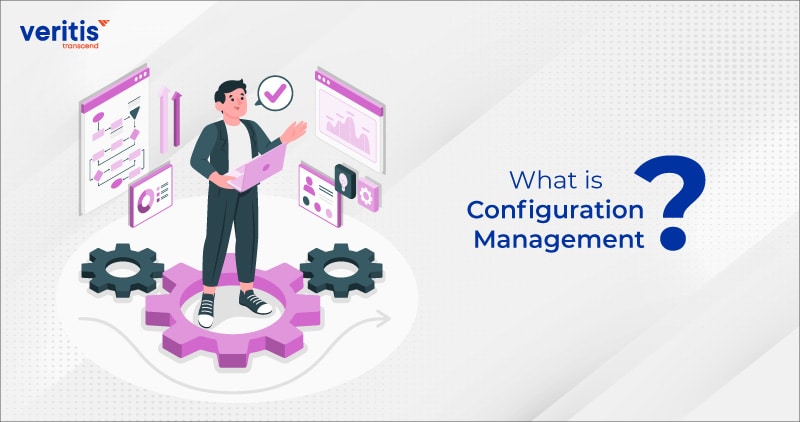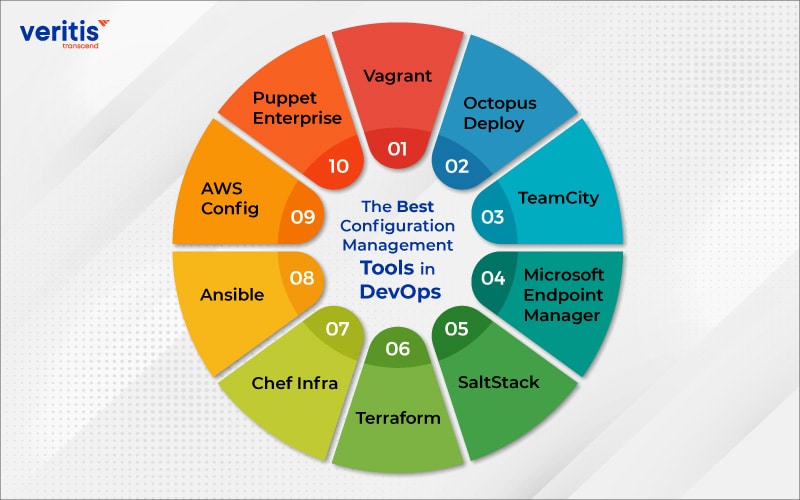
It’s crucial to familiarize yourself with several key fundamental disciplines to understand the DevOps concept comprehensively within an organization. These encompass coding, building, testing, packaging, release, configuration, and monitoring, each accompanied by various best practices.
Configuration management holds significance in DevOps transformation by enabling the DevOps automation of otherwise laborious tasks and facilitating increased organizational agility. Furthermore, it is recognized that configuration management tools play a vital role in supporting DevOps transformation comprehensively, emphasizing its essential nature in the DevOps Practices framework rather than being perceived as just another process component.
Developing and sustaining extensive modern IT systems without DevOps automation can be labor-intensive, posing heightened risks associated with human errors. Automated configuration and resource management serve as efficient approaches to uphold computer systems and software in a predictable and uniform state.
What is Configuration Management?

Configuration management becomes active when a configuration platform is utilized to automate, supervise, plan, and oversee manual configuration processes. This entails implementing comprehensive changes across servers, networks, storage, applications, and other managed systems.
A crucial role of IT configuration management is establishing each system’s state. By coordinating these procedures through a platform, companies can guarantee uniformity across interconnected systems, increasing efficiency. Consequently, businesses can expand more effortlessly without additional IT management personnel. Companies lacking extensive resources can experience growth by adopting a DevOps Practices approach.
It’s important to note that cloud configuration management is often conflated with change management. Configuration management primarily involves the DevOps automation, management, and upkeep of configurations in various states. In contrast, change management is the process of redefining configurations to meet new requirements and dynamic conditions.
Numerous tools are available for organizations looking to implement IT configuration management. Puppet has been a trailblazer in this field, but companies like Chef and Red Hat also provide compelling suites of products to improve IT configuration management processes. Effective configuration management is fundamental to continuous testing and delivery, a key advantage of DevOps transformation.
Useful link: Top 10 Skills That Make A ‘Perfect’ DevOps Engineer
Why is Configuration Management Important?
Configuration management prevents discrepancies among software versions during testing, ensuring the ongoing consistency of configurations. It plays a vital role in maintaining comprehensive documentation and reporting, preventing oversight of minor system changes and misconfigurations that could compromise performance and give rise to additional issues. This, in turn, helps minimize downtime and promotes overall system stability. In IT configuration management, specific tools and strategies are applied to circumvent the necessity for manual tasks in vast software environments where entirely manual processes are highly impractical. This includes tasks such as prioritizing actions and validating completions.
The configuration management process simplifies the experiences of both administrators and users by offering practical ways to establish baseline system settings. Adhering to these settings from the outset ensures smoother, more stable, and error-free outcomes.
What is DevOps Configuration Management?
In simple terms, configuration management involves outlining, modifying, releasing, overseeing, documenting, and reporting the arrangement of items within a system, regardless of the sequence. It’s akin to ensuring you have all the puzzle pieces when assembling a puzzle. When implemented effectively in DevOps transformation, the configuration management process enables developers to make swift and efficient system changes without causing disruptions. Additionally, it facilitates tracking updates, changes, and incidents prompting those changes.
Within well-managed DevOps configuration, two key results emerge: 1) Infrastructure as code and 2) Configuration as code

1) Infrastructure as Code
In the context of DevOps configuration management, Infrastructure as Code (IaC) involves handling and provisioning infrastructure using code rather than manual configuration via a web interface or command-line interface. This methodology enables the version control, testing, and automation of infrastructure, mirroring the processes applied to application code.
This approach enables infrastructure management, like handling applications, simplifying consistent deployments, rollbacks to previous versions when necessary, and transparent, traceable tracking of infrastructure changes. Commonly utilized tools for infrastructure such as Code (IaC) encompass Ansible, Chef, Puppet, and Terraform.
Consider the scenario where you intend to create a web application on a cloud provider like AWS. In the conventional approach, you must manually set up a virtual server, install the operating system, adjust the network settings, and install the application-specific software.
Utilizing Infrastructure as Code involves scripting the necessary infrastructure for running your application. This script specifies the server type, required memory, and necessary software installations. Once the script is developed, tools like Terraform can seamlessly create the server, configure it, and install the essential software with a single command. This method ensures the creation of a consistently reproducible infrastructure, simplifying future management.
2) Configuration as Code
Implementing Configuration as Code (CaC) involves managing and configuring your system and applications through code rather than manual modifications. This approach enables the tracking of changes, facilitates testing, and allows for automation, mirroring the processes applied to your application’s code. By managing settings like the application, it becomes easier to swiftly deploy or roll back changes, monitor utilized settings, and ensure smooth operation. Additionally, harnessing the power of code can be akin to casting spells when managing your configuration.
An illustration of delivering configuration as code is utilizing a tool such as Ansible to configure a web server. Instead of manual configuration, an Ansible script can automatically set up the web server. This script configures the web server with the right software version, determines the number of worker processes, and defines its root directory. It creates a predefined recipe for configuring the web server, which can be saved, reviewed, and tested before execution.
Useful link: Top 10 DevOps Tools to Pick for Your Business
The Best Configuration Management Tools in DevOps

Here is a compilation of the ten finest and most widely used (in no specific order) configuration management tools in DevOps practices:
1) Vagrant
Specializing in constructing and managing virtual machine environments, Vagrant minimizes the time required for setting up development environments and enhances production parity. It facilitates easy sharing of virtual environment configurations among team members. Notably, Vagrant’s advantage lies in locally provisioning and handling data files before implementing changes in interconnected environments.
2) Octopus Deploy
Octopus simplifies the management of intricate deployments in both physical and cloud environments. The solution is equipped to eradicate common deployment errors, streamline software deployment tasks within your team, facilitate deployments in unfamiliar environments, and ultimately increase the number of releases within a specified timeframe.
3) TeamCity
TeamCity, a robust CI and build management solution by JetBrains, seamlessly integrates source code from various version control systems into a single build. It enables reusing parent project settings in subprojects, effectively identifies hung builds, and highlights builds for future reference. With a user-friendly Project Overview, TeamCity is an excellent DevOps CI/CD solution, enhancing build checks and providing workflow flexibility across diverse environments.
4) Microsoft Endpoint Manager
Endpoint Manager enhances endpoint security, offers comprehensive device management, and provides increased flexibility in managing actions in the cloud. Whether dealing with servers, virtual machines, desktops, or mobile devices, Endpoint Manager allows monitoring and management across various objects and environments, whether in the cloud or on-premises. It facilitates the creation of practical configuration profiles, compliance and app protection policies, and the configuration of Windows Update settings, among other features.
5) SaltStack
Based on Python, this configuration tool utilizes SSH and push methods to enhance communication between businesses and clients. Operating akin to the execution of ad-hoc scripts, the platform offers a more sophisticated and well-structured workflow infused with substantial automation, streamlining typical continuous DevOps implementation and delivery processes.
6) Terraform
A versatile open-source SCM platform simplifies the management of clusters, services, and cloud infrastructure using Infrastructure as Code (IaC). It seamlessly integrates with Azure, AWS, and other cloud solutions, offering distinct databases, servers, and essential object interfaces. This platform facilitates repeatable deployments of cloud infrastructures, enabling autonomous provisioning of AWS resources from text files and handling deployment tasks efficiently.
Useful link: Why Startups ‘Fail’ in DevOps? Identify Gaps and Take Right Approach
7) Chef Infra
Chef’s infrastructure tools, designed for DevOps, elevate IT management flexibility and efficiency. They accelerate software delivery by streamlining the building, testing, and patching of new environments. These tools ensure proper deployment of software versions, enhance system resiliency and manage risks through dedicated metrics. Chef enables the seamless and continuous delivery of any infrastructure type in diverse environments.
8) Ansible
Ansible is our company’s predominant and familiar tool, liberating developers from repetitive tasks and enabling a heightened focus on strategic endeavors. This ensures that routine tasks no longer impede complex processes. The framework utilizes executable XML or YAML configuration files to articulate system configuration algorithms.
The appropriate Python-based executables subsequently execute the specified sequence of actions. Ansible proves to be relatively easy to grasp and doesn’t necessitate distinct agents for node management, relying on the Paramiko module and standard SSH for this purpose.
9) AWS Config
AWS Config facilitates the thorough auditing, assessment, and examination of configurations associated with AWS resources. The secrets tracking features are particularly noteworthy, enabling the detailed tracking of resource configuration histories. Users can review customizations in AWS resource configurations, assess inter-relationships, and establish comprehensive compliance with configurations outlined by internal guidelines.
10) Puppet Enterprise
This tool comes in two versions – Puppet and Puppet Enterprise. The former offers a free, open-source version, while the latter is free for up to ten nodes. Puppet is a well-structured tool utilizing modules for organization and swift adjustments. It enables orchestrated remediation, monitors ongoing changes, and facilitates rapid deployment planning and DevOps implementation. Additionally, it allows centralized server management infrastructure definition as code and ensures enforced system configurations.
Conclusion
Configuration management solutions’ paramount importance and advantages in DevOps, CI/CD, Agile, and other IT management methodologies cannot be overstated. These solutions are pivotal in automating intricate processes effectively eliminating common issues and human errors. Products like Ansible and Terraform are invaluable assets for structuring and organizing software environments, ensuring seamless execution and optimization. If you need to pay attention to configuration management tools in your work, rectifying the situation and leveraging the SCM capabilities available in the market right now is imperative.
At Veritis, a distinguished recipient of esteemed accolades such as the Stevie and Globee Business Awards, we offer comprehensive configuration management solutions tailored to optimize your IT workflows and enhance overall efficiency.
Got Questions? Schedule A Call
Additional Resources:
- Chef Vs Puppet Vs Ansible – Comparison of DevOps Configuration Management Tools
- Which AWS Cloud Management Tools Should You Use to Manage Your Business
- Explained: Pros and Cons of DevOps Methodology and its Principles
- DevOps outsourcing: Things to Know About Before Getting Started
- How to Implement Artificial Intelligence in DevOps Transformation?